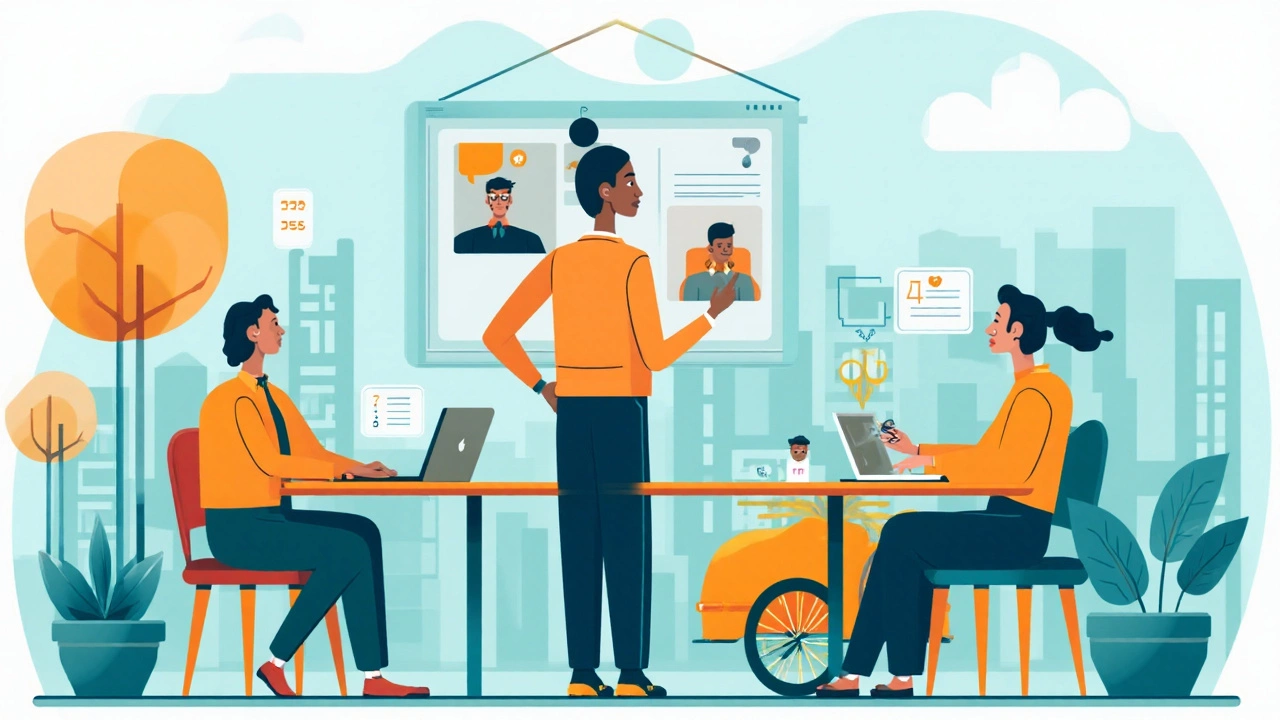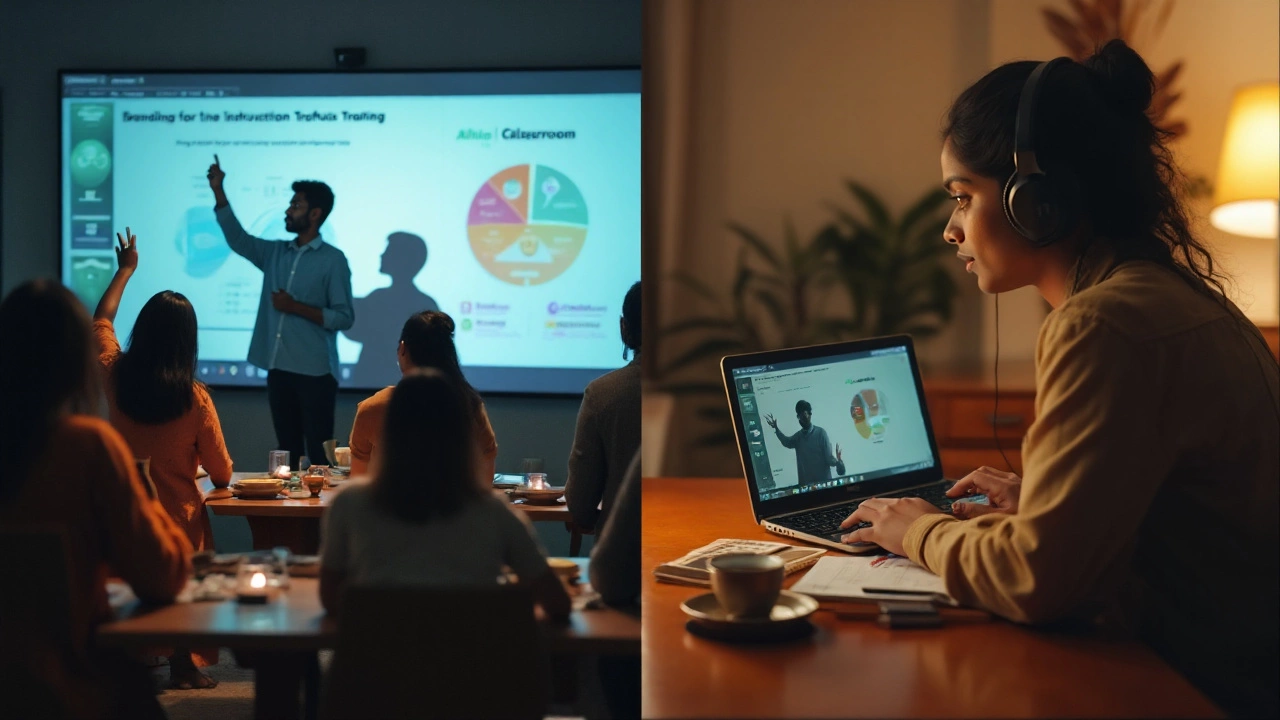People mix these up all the time: are virtual learning and eLearning the same thing? They overlap, but they’re not identical. The short version: eLearning is the big umbrella for digital learning content and delivery; virtual learning is the live, online classroom slice of that umbrella. Think Netflix vs live TV. Both come through a screen, but the experience, pacing, and tools differ.
eLearning is a form of education delivered via digital technologies (web, mobile, apps) that can be self-paced or instructor-led, using content like videos, quizzes, interactive modules, and assessments, typically hosted on platforms such as learning management systems.
Virtual learning is a live, online learning experience conducted in a virtual classroom using web conferencing tools, where learners and instructors interact in real time with audio, video, chat, polls, and breakout rooms.
TL;DR
- eLearning vs virtual learning: eLearning is any digital learning. Virtual learning is the live, synchronous part of eLearning.
- Use virtual learning for coaching, discussion-heavy classes, labs, and rapid alignment.
- Use eLearning (self-paced) for scale, compliance, onboarding, and just-in-time skills.
- Most teams blend both: pre-work in eLearning, live session for practice, follow-up microlearning.
- Match the format to attention span, time zones, tech access, and assessment needs.
What each term really means (and why the confusion happens)
There’s a reason people mash these terms together: both happen online, and many platforms do both. But precision helps you choose the right mix, budget correctly, and track impact.
Online learning is the broader category: any learning conducted via the internet, including eLearning, virtual learning, MOOCs, microlearning, and blended setups.
Here’s the practical split: eLearning can be live or self-paced; virtual learning is specifically live and interactive. Most self-paced programs are eLearning but not virtual. Most virtual classes are eLearning, but not all eLearning is virtual.
Live vs self-paced: the timing matters more than the tech
Timing dictates experience. That’s why “synchronous” and “asynchronous” are the two words that actually sort the mess.
Synchronous learning is real-time instruction where learners and instructors meet at the same time, usually in a virtual classroom, enabling immediate feedback and group interaction.
Asynchronous learning is on-demand instruction where learners access content at their own pace, with progress tracking, quizzes, and forums replacing real-time interaction.
Virtual learning is typically synchronous. Self-paced eLearning is asynchronous. Many courses use both: watch a 20-minute module (asynchronous), then join a 60-minute live workshop (synchronous) to practice.
The core tools: where content lives and where people meet
Two platforms dominate your stack: the system where content lives and the room where people meet.
Learning management system (LMS) is a platform used to host, deliver, track, and report on eLearning content, enrollments, and assessments; common features include SCORM/xAPI support, learning paths, badges, and analytics.
Virtual classroom is a live web conferencing environment with features like video, screen share, whiteboards, breakout rooms, attendance tracking, and recordings for playback.
In practice, the LMS manages the course and records; the virtual classroom hosts the live session. Some platforms bundle both. The key is not to confuse the platform (tool) with the pedagogy (how you teach).
Blended learning: the best of both worlds
Most teams land here-mixing formats to get reach and depth without burning the calendar or budget.
Blended learning is an instructional model that combines asynchronous eLearning with synchronous sessions (virtual or in-person) to optimize time, engagement, and practice.
A simple flow: pre-work (video + quiz), live workshop (role-play in breakout rooms), post-work (microlearning nudges + a practical assignment). Research from the U.S. Department of Education’s meta-analysis found that blended approaches tend to outperform purely in-person or purely online when designed intentionally. In 2024-2025, universities and employers alike continue to push blended models because they respect time zones, attention spans, and cost.
Comparison: eLearning vs virtual learning vs online learning
| Attribute | eLearning | Virtual learning | Online learning |
|---|---|---|---|
| Timing | Either self-paced or live | Live (synchronous) | Umbrella term (includes both) |
| Primary tools | LMS, authoring tools, quizzes | Virtual classroom, whiteboards, polls | Varies: LMS, virtual classroom, forums |
| Best for | Scale, compliance, onboarding | Coaching, discussions, labs | Describing the whole ecosystem |
| Interaction | Limited in-module; delayed feedback | High, real-time feedback | Depends on the chosen formats |
| Assessment | Quizzes, simulations, assignments | Live tasks, presentations, breakout activities | Any of the above |
| Scalability | High once content is produced | Moderate; limited by facilitator time | N/A (category-level) |
| Example | 30-minute safety module with a certificate | 90-minute live workshop with role-plays | A degree delivered with both modules and live classes |
When to use which: simple rules of thumb
- If you need scale across time zones: lead with asynchronous eLearning.
- If the skill is interpersonal or judgment-heavy: include virtual learning for practice and feedback.
- If compliance or certification is the goal: eLearning with rigorous assessments + occasional live Q&A.
- If change management or alignment is urgent: kick off with a short virtual town hall, then push targeted eLearning follow-ups.
- If bandwidth and attention are limited: use microlearning (3-7 minutes) for knowledge, save virtual time for doing, not telling.
Standards, data, and content portability (so your work doesn’t vanish)
Ever switched platforms and lost progress data? Standards help avoid that.
Two names matter: SCORM for packaging content and tracking basic scores/complete states, and xAPI for richer activity streams across apps. UNESCO’s 2023 reports highlighted the expansion of online learning infrastructure post-2020 and the need for interoperability; xAPI has been central to cross-platform reporting in many enterprise rollouts. If you’re buying content, ask vendors which standard they support and test a sample in your LMS before you commit.
Accessibility and inclusion
Designing for everyone isn’t optional. The W3C’s WCAG 2.2 guidelines define clear requirements: captions, transcripts, keyboard navigation, contrast, and logical structure. For virtual learning, plan for interpreters or live captioning, slower pacing, and chat-based participation options. For eLearning, write alt text, avoid auto-playing audio, and ensure mobile-friendly layouts. In 2025, many institutions require compliance statements and audit trails, so bake accessibility into templates, not just final checks.

Costs and timelines: where time actually goes
- Self-paced eLearning: most time goes into instructional design, media, and testing. Expect 40-120 hours of development per finished hour of quality content, depending on interactivity.
- Virtual learning: more time lands in facilitation design, materials, and rehearsal. Expect 8-20 hours of prep per 1 hour live for high-stakes sessions (less for informal).
- Blended programs: save live time by moving knowledge transfer to pre-work; spend live time on practice. This usually improves completion rates and satisfaction scores.
Real-world scenarios
K-12: Teachers often assign short modules for content, then run 30-45 minute virtual classes for discussion and group work. Shorter, more frequent sessions beat long marathons, especially for younger learners.
Higher ed: Lectures shift to recorded content; live time becomes seminars, case discussions, or labs. Labs may use virtual simulations or remote kits to keep hands-on elements.
Corporate: Onboarding starts with a self-paced path (policies, systems), then a weekly live cohort session for Q&A and culture. Sales training uses scenario sims in eLearning, followed by live role-plays.
Compliance: eLearning modules handle the heavy lifting (versioning, audits, retakes). Quarterly virtual refreshers keep policy alive with real case reviews.
Design patterns that work in 2025
- Flip the classroom: assign 20 minutes of eLearning pre-work; keep lives sessions under 75 minutes with clear practice tasks.
- Chunk it: microlearning for facts; virtual labs for skills. Avoid multi-hour live lectures unless it’s a special event.
- Social proof: discussion forums or cohort chat to keep momentum; use leaderboards or badges sparingly to motivate, not distract.
- Assess twice: quick checks in eLearning, then demonstrate in the live session. Record outcomes in the LMS for a full picture.
- Follow-up nudges: send 2-3 spaced reminders with tiny tasks (1-3 minutes) to lock in retention.
Common pitfalls and how to avoid them
- Zoom ≠ strategy: picking a web meeting tool without a curriculum leads to poor outcomes. Start with objectives and assessment.
- One-size-fits-none: forcing everything live or everything self-paced hurts engagement. Blend formats based on the skill.
- Ignoring accessibility: captions and transcripts aren’t afterthoughts. Bake them into the plan.
- No analytics: if you can’t measure completion, attempts, and performance, you can’t improve. Set up reports early.
- Overlong sessions: cut live sessions to the essentials and practice. Move lectures to eLearning and keep recordings short with chapter markers.
How to choose: a simple decision flow
- Define the outcome: knowledge, skill, attitude, or behavior change?
- Judge the complexity: is practice with feedback required?
- Check constraints: time zones, devices, bandwidth, schedules.
- Map the mix:
- If knowledge only and large audience → self-paced eLearning.
- If skill with nuance → eLearning pre-work + virtual practice.
- If culture/alignment → short virtual kickoff + eLearning follow-ups.
- Select platforms: LMS for hosting and tracking; virtual classroom for live parts.
- Plan assessment: quiz for recall; simulation or live demonstration for skills.
- Schedule reinforcement: microlearning, office hours, and automation for nudges.
Related concepts worth knowing
- MOOCs (massive open online courses) for wide access; great for foundational topics.
- Microlearning for quick hits in workflows.
- Mobile learning (mLearning) to meet learners on phones first.
- Learning experience platforms (LXP) for personalized discovery and curation.
- Credentialing and digital badges to prove skills to employers.
Quick definitions recap (for reference)
Here are the key terms you’ll keep meeting in specs, RFPs, and classroom plans:
- eLearning digital learning delivered via devices; can be self-paced or live; hosted and tracked in an LMS.
- Virtual learning live, synchronous sessions in a virtual classroom with real-time interaction.
- Online learning the broad category that includes both eLearning and virtual learning.
- Learning management system (LMS) the system that delivers, tracks, and reports learning content and outcomes.
- Virtual classroom the live meeting environment with features for teaching and group work.
- Synchronous learning real-time sessions with immediate feedback and collaboration.
- Asynchronous learning on-demand modules, forums, and assignments without a live meeting.
- Blended learning a designed mix of asynchronous and synchronous formats.
Next steps
- Write a one-page plan: audience, objectives, constraints, and the blended flow.
- Pick an LMS that supports SCORM/xAPI, good analytics, and SSO. Pilot with 30 users before rollout.
- Choose a virtual classroom with breakout rooms, captions, and strong recording tools.
- Draft a 60-20-20 mix: 60% self-paced knowledge, 20% live practice, 20% reinforcement.
- Set success metrics: completion, assessment scores, and on-the-job outcomes (e.g., time to proficiency).
Troubleshooting quick fixes
- Low completion? Cut module length, add progress saves, and send calendar invites with time estimates.
- Poor virtual engagement? Use cold-calls fairly, polls every 10-15 minutes, and breakout tasks with clear roles.
- Spotty data? Standardize naming in the LMS and test SCORM/xAPI statements with a sample cohort.
- Accessibility gaps? Add captions and transcripts, check color contrast, and provide downloadable outlines.
- Facilitator fatigue? Rotate facilitators, script time cues, and reuse structured slides with timers.

Frequently Asked Questions
Are virtual and eLearning the same?
No. eLearning is the broad category of digital learning, which can be self-paced or live. Virtual learning is specifically live, synchronous learning in an online classroom. All virtual learning is eLearning, but not all eLearning is virtual.
Is a recorded webinar eLearning or virtual learning?
The live webinar is virtual learning (synchronous). The recording becomes asynchronous eLearning once it’s posted for on-demand viewing, especially if you add a quiz or tracking in the LMS.
Which format is better for skill-building?
A blend works best. Use eLearning to prime knowledge and save time; use virtual learning for coached practice, feedback, and scenario work. This combo consistently beats either format alone for applied skills.
What standards should my LMS and content support?
At minimum, SCORM for packaging and basic tracking. For richer data across tools (e.g., simulations, mobile apps), xAPI is better. Ask vendors for a sample package and test reporting before rollout.
How long should virtual sessions be?
Aim for 45-75 minutes with interaction every 10-15 minutes. If you need more time, break the class into modules with short breaks and clear task outcomes.
What accessibility steps are non-negotiable?
Captions and transcripts, keyboard navigation, readable contrast, and clear structure. Align to WCAG 2.2 guidelines. For live sessions, offer live captions and alternative participation paths (chat, polls).
How do I measure success beyond completion rates?
Track assessment scores, time to proficiency, error rates on the job, and manager feedback. Use pre/post measures and tie outcomes to business metrics like sales conversion or safety incidents.
Is blended learning more expensive?
Not necessarily. You invest up front in eLearning content but save facilitator time. Many teams reduce total live hours by 30-50% while improving performance because live time is focused on practice.
Authoritative sources to explore: UNESCO’s 2023 education technology updates for global infrastructure trends, the OECD’s online learning reports for policy impacts, and the W3C’s WCAG 2.2 for accessibility standards. For quality frameworks, see ISO 29993 for learning services outside formal education.
